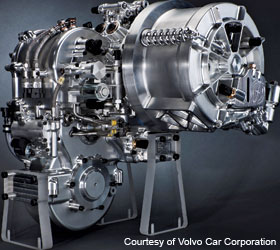

When a driver applies the brakes in a conventional passenger car, much of the energy from the vehicle’s inertia is converted to heat and lost. It’s a waste of valuable energy that has been built up, largely by the engine. Now global carmaker, Volvo is exploring ways to recover some of the energy expended during braking so that it can be reused within the vehicle when it’s most needed.
At the Volvo Car Group transmission division’s R&D department in Sweden, Thomas Hannebäck, director of transmission engineering, explains that while various forms of KERS technology are currently used in Formula 1 racing cars, Volvo is the first automobile manufacturer to develop a front wheel driven combustion engine car with the KERS flywheel technology fitted to the rear axle. “We are now exploring various options with potential suppliers to industrialise the concept for Volvo cars,” he says.
The team has successfully adapted the system to a Volvo S60 T5, which was specially rebuilt for the project. The vehicle’s conventional and unconventional power sources are located separately. The petrol engine powers the front wheels, while the KERS unit drives the rear wheels. The KERS flywheel is the heart of the project. It weighs six kilograms and rotates at up to 60 000 rpm in a vacuum-sealed container. When the vehicle is being driven, the flywheel captures energy generated by braking and stores it for up to 30 minutes. This energy can be released when required to boost acceleration. Power is transferred from the brakes to the flywheel via a continuously variable transmission (CVT), which then transfers the power to the rear axle during acceleration. The KERS technology can effectively add up 60 kilowatts, or the equivalent of another two cylinders of power, to a four-cylinder engine.
On the energy reduction side, the KERS technology is expected to help meet the EU’s reduced passenger car emissions target of 95 g/km of CO2 by 2020 for a fleet average – a significant drop from 158,7 g/km for a 2007 fleet average. The development of the KERS flywheel was the result of an intensive cross-functional effort, involving just about every department within Volvo Cars, from electronics and safety to engine and chassis. Outside partners, Flybrid Automotive and Torotrak, were called on to develop a range of critical parts for the concept, including the carbon-fibre flywheel and the CVT. The supplied parts were then adapted to the requirements of the Volvo S60 T5. The total cost of the project was R32,3 million. Volvo Car Group contributed some R17,6 million and the remaining costs were met by Swedish innovation agency Vinnova, SKF and Volvo Trucks. SKF’s role in the project was to evaluate the cost of producing the Volvo KERS flywheel on an industrial scale.
A major challenge for lead engineer, Mathias Jörgensson and his team was to integrate the flywheel and CVT with all of the Volvo S60 T5 systems, including the brakes, gears, clutch and transmission. The gear ratios had to be coordinated with the parameters for the flywheel. This was to make sure the most efficient fuel economy and performance of gearshifts were realised during transitions from standstill and acceleration while driving at higher speeds. “We had to synchronise all these systems to provide smooth engagement,” Jörgensson says. Finding an unobtrusive location for the flywheel proved a challenge. Eventually, the engineers settled on placing it in the trunk where the spare tyre was located.
SKF was approached by Volvo Car Corporation in early 2011 and asked to evaluate the costs of producing the KERS flywheel system on an industrial scale.
The evaluation work was undertaken by the SKF Automotive Development Centre at Nieuwegein in the Netherlands and involved assessing each of the 90 components used by the system. Estimates for parts that could potentially be made by SKF were supplied by the relevant SKF unit. SKF Aerospace, for example, provided the estimate for the carbon-fibre flywheel rim. For parts likely to be outsourced, such as hydraulics, SKF requested quotations from suppliers.
The final system cost estimate included component manufacturing, purchasing, assembly and testing. Project manager, Mark Verbakel says the final results of the study met with a positive reaction when presented to Volvo.
For more information contact Samantha Joubert, SKF South Africa, +27 (0)11 821 3500, [email protected], www.skf.co.za
| Tel: | +27 11 821 3500 |
| Fax: | +27 11 821 3501 |
| Email: | [email protected] |
| www: | www.skf.co.za |
| Articles: | More information and articles about SKF South Africa |
© Technews Publishing (Pty) Ltd | All Rights Reserved